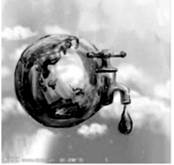题型:阅读选择 题类:模拟题 难易度:普通
浙江省衢州市2020年中考英语复习卷(一)(外研版)(含听力音频)

The world uses about a thousand million(百万) tons of water a day. Water is a human right and everyone should have their share. Yet more than 700 million people around the world have trouble getting clean, safe water.
Treating wastewater is a good way to provide fresh water for us. And it, also helps the environment by keeping waste out of rivers and oceans. 80% of wastewater around the world is not treated at all, and it is running into oceans. But now we have got the technology to treat and reuse the wastewater.
While 75% of our planet is covered with water, only about 2% is fresh water一that comes from rivers, lakes, ice and snow. The rest, 98% of the water, is in seas and oceans. It is too salty to drink. Then desalination (淡化) businesses come in. More than 19,000 factories have been built around the world, mostly in coastal countries. They process (加工) more than 92 million tons of water every day. But the technology they use requires a lot of energy.
Scientists are working to create a less costly technology. They want to produce 20 times more clean water and make sure everyone has enough. But for now, the world still faces each day with not having enough water for everyone.
试题篮